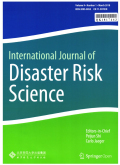- 钛学术文献服务平台 \
- 学术期刊 \
- 医药卫生期刊 \
- 预防医学与卫生学期刊 \
- 国际灾害风险科学学报(英文版)期刊 \
Disaster Risk Science:A Geographical Perspective and a Research Framework
Disaster Risk Science:A Geographical Perspective and a Research Framework
基本信息来源于合作网站,原文需代理用户跳转至来源网站获取
摘要:
In this article,we recall the United Nations' 30-year journey in disaster risk reduction strategy and framework,review the latest progress and key scientific and technological questions related to the United Nations disaster risk reduction initiatives,and summarize the framework and contents of disaster risk science research.The object of disaster risk science research is the "disaster system" consisting of hazard,the geographical environ-ment,and exposed units,with features of regionality,interconnectedness,coupling,and complexity.Environ-mental stability,hazard threat,and socioeconomic vulner-ability together determine the way that disasters are formed,establish the spatial extent of disaster impact,and generate the scale of losses.In the formation of a disaster,a conducive environment is the prerequisite,a hazard is the necessary condition,and socioeconomic exposure is the sufficient condition.The geographical environment affects local hazard intensity and therefore can change the pattern of loss distribution.Regional multi-hazard,disaster chain,and disaster compound could induce complex impacts,amplifying or attenuating hazard intensity and changing the scope of affected areas.In the light of research progress,particularly in the context of China,we propose a three-layer disaster risk science disciplinary structure,which contains three pillars (disaster science,disaster technology,and disaster governance),nine core areas,and 27 research fields.Based on these elements,we discuss the frontiers in disaster risk science research.

推荐文章
Entity Framework浅析
EDM
ADO.NET
Entity Framework
编程员
Entity Framework数据库访问
数据库
模型
代码
Entity Framework技术
基于Java Media Framework的实时音/视频通信
JMF
RTP
实时通信
音/视频流
e-Science技术综述
e-Science
Grid
分布式计算
内容分析
关键词云
关键词热度
相关文献总数
(/次)
(/年)
文献信息
| 篇名 | Disaster Risk Science:A Geographical Perspective and a Research Framework | ||
| 来源期刊 | 国际灾害风险科学学报(英文版) | 学科 | |
| 关键词 | |||
| 年,卷(期) | 2020,(4) | 所属期刊栏目 | ARTICLES |
| 研究方向 | 页码范围 | 426-440 | |
| 页数 | 15页 | 分类号 | |
| 字数 | 语种 | 英文 | |
| DOI | |||
五维指标
引文网络
引文网络
二级参考文献 (126)
共引文献 (311)
参考文献 (58)
节点文献
引证文献 (0)
同被引文献 (0)
二级引证文献 (0)
1984(1)
- 参考文献(0)
- 二级参考文献(1)
1991(3)
- 参考文献(0)
- 二级参考文献(3)
1994(1)
- 参考文献(0)
- 二级参考文献(1)
1995(1)
- 参考文献(0)
- 二级参考文献(1)
1996(4)
- 参考文献(0)
- 二级参考文献(4)
1997(1)
- 参考文献(0)
- 二级参考文献(1)
1998(2)
- 参考文献(0)
- 二级参考文献(2)
1999(3)
- 参考文献(0)
- 二级参考文献(3)
2000(2)
- 参考文献(0)
- 二级参考文献(2)
2001(5)
- 参考文献(0)
- 二级参考文献(5)
2002(11)
- 参考文献(0)
- 二级参考文献(11)
2003(7)
- 参考文献(1)
- 二级参考文献(6)
2004(1)
- 参考文献(0)
- 二级参考文献(1)
2005(12)
- 参考文献(2)
- 二级参考文献(10)
2006(18)
- 参考文献(0)
- 二级参考文献(18)
2007(5)
- 参考文献(1)
- 二级参考文献(4)
2008(7)
- 参考文献(2)
- 二级参考文献(5)
2009(10)
- 参考文献(1)
- 二级参考文献(9)
2010(7)
- 参考文献(0)
- 二级参考文献(7)
2011(4)
- 参考文献(1)
- 二级参考文献(3)
2012(6)
- 参考文献(2)
- 二级参考文献(4)
2013(7)
- 参考文献(2)
- 二级参考文献(5)
2014(9)
- 参考文献(5)
- 二级参考文献(4)
2015(17)
- 参考文献(7)
- 二级参考文献(10)
2016(10)
- 参考文献(5)
- 二级参考文献(5)
2017(5)
- 参考文献(4)
- 二级参考文献(1)
2018(12)
- 参考文献(12)
- 二级参考文献(0)
2019(9)
- 参考文献(9)
- 二级参考文献(0)
2020(4)
- 参考文献(4)
- 二级参考文献(0)
2020(4)
- 参考文献(4)
- 二级参考文献(0)
- 引证文献(0)
- 二级引证文献(0)
引文网络交叉学科
相关学者/机构
期刊影响力
国际灾害风险科学学报(英文版)
主办单位:
民政部国家减灾中心和北京师范大学
出版周期:
季刊
ISSN:
2095-0055
CN:
11-5970/N
开本:
16开
出版地:
北京市
邮发代号:
创刊时间:
2010
语种:
eng
出版文献量(篇)
272
总下载数(次)
0
期刊文献
相关文献
推荐文献

 免费查重
免费查重










